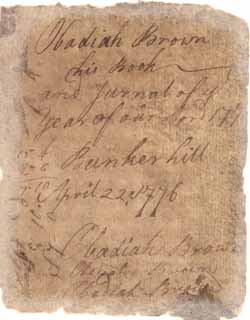Collections Online
Obadiah Brown diary, 1776-1777
To order an image, navigate to the full
display and click "request this image"
on the blue toolbar.
-
Choose an alternate description of this item written for these projects:
- Main description
[ This description is from the project: Siege of Boston ]
This diary kept by Obadiah Brown, a soldier from Gageborough (now Windsor), Massachusetts, who served as a private in a regiment near Boston during the Siege and in upstate New York in 1777, contains entries dating from 30 January 1776 to 7 January 1777. Brown's entries written during the Siege of Boston include brief descriptions of basic military duties, summaries of British troop activities, a statement about being fired upon while standing guard at Lechmere Point, and daily life--disciplinary actions and injuries--in his regiment. Brown's diary also describes his military experiences after the Siege of Boston when his regiment went to New York where he was shot in the arm.
After the Siege of Boston, Brown remained in the area until mid-July performing fatigue duties, visiting hospitals and giving reports in his diary about deaths, injuries and activities. Once in New York & Long Island, Brown details a very active military scene until 16 September 1776 when he was shot in the arm. Brown’s recovery was long and painful and he recounts a number of surgeries and the pain he experiences. He is moved from New York, to New Jersey, to Connecticut, all the while maintaining a journal of military exchanges of which were related to him by fellow soldiers. In mid-December he began the long trek back to Gageborough, arriving there in early January 1777. Throughout his diary, Brown mentions going on fatigue duty which refers to manual labor that soldiers were often required to do, for example digging ditches or trenches.
Brown was from Gageborough (incorporated in 1771), which was so named to compliment then Governor Thomas Gage. Gage was unpopular with Americans of Massachusetts Bay and many of his actions incited the patriots; increasing their motivation to seek independence from Britain. In 1778, however, the town was renamed to Windsor reflecting the desire to move beyond its colonial associations.
After the Siege of Boston, Brown remained in the area until mid-July performing fatigue duties, visiting hospitals and giving reports in his diary about deaths, injuries and activities. Once in New York & Long Island, Brown details a very active military scene until 16 September 1776 when he was shot in the arm. Brown’s recovery was long and painful and he recounts a number of surgeries and the pain he experiences. He is moved from New York, to New Jersey, to Connecticut, all the while maintaining a journal of military exchanges of which were related to him by fellow soldiers. In mid-December he began the long trek back to Gageborough, arriving there in early January 1777. Throughout his diary, Brown mentions going on fatigue duty which refers to manual labor that soldiers were often required to do, for example digging ditches or trenches.
Brown was from Gageborough (incorporated in 1771), which was so named to compliment then Governor Thomas Gage. Gage was unpopular with Americans of Massachusetts Bay and many of his actions incited the patriots; increasing their motivation to seek independence from Britain. In 1778, however, the town was renamed to Windsor reflecting the desire to move beyond its colonial associations.

